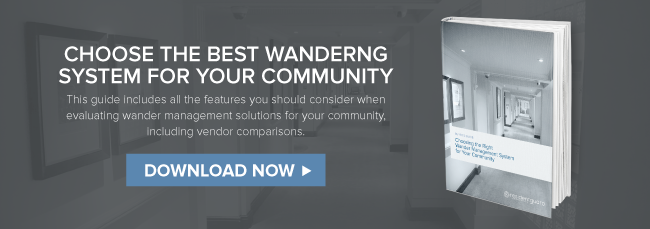
On January 7, a memory care resident at the Hilty Memorial Home in Ohio was found dead. Phyllis Campbell died of hypothermia after exiting the building through a propped open door, yet wasn’t even discovered missing by staff for several hours.
Why did it happen?
A report from the Ohio Department of Health found that Campbell exited the building around 12:35 a.m., likely died between 1:00 and 2:00 a.m., and wasn’t discovered by staff until 8:20 a.m. However, bed checks at 2:00 and 4:00 a.m. documented (fraudulently) that Campbell was in her room. Now three Hilty Home staff members are being charged on a number of charges including involuntary manslaughter, forgery and gross patient neglect.
In addition to the neglect of staff, a faulty wander management system was found to be a culprit in Campbell’s death. As we discussed in a previous blog coving this tragic case, it highlights the critical need for a reliable, effective wander management system.
At the time of her death, Campbell was wearing a wander device which triggered on alarm on the exit door. The audible alert only lasted 90 seconds and was either unheard by staff or malfunctioned completely. Testing other wander devices at the facility found more unreliable performance.
What you need in a wander management system
As we all know, there will always be human error and occasionally misconduct, so it’s critical to also use a sophisticated wander management system for security purposes. As Hilty Home experienced first-hand, some wander management solutions are less reliable than others, which can lead any facility open to devastating losses and significant liability.
Consider the following in choosing a system (or evaluating if yours is sub-par):
- Reliability: How often are there false alarms or interference with other sources? More importantly, how often does the system malfunction?
- Adequate alarms: Alarms should be multifaceted (visual, audio, etc.) and impossible for staff to ignore. Find a system with custom alarm capabilities so you can configure to fit your facility’s needs.
- Integration: Make sure your system integrates with your facility’s other security measures, including nurse call, EAC, CCTV and fall detection
Want more guidance on choosing the right wander management solution for your community? Learn purchasing tips and essential features to look for in this guide.
Topics: Hospital, News, ResidentGuard
SUBSCRIBE TO OUR NEWSLETTER!
RECENT POSTS
- The Future of Baby Footprinting
- Addressing the Rise of Dementia with ResidentGuard Wander Management Solutions
- The Evolution of Infant Protection in Healthcare Technology
- Safeguarding Patient Privacy with Role-Based Access Control
- Essential Features of an Access Control System
- Groundbreaking Blood Test for Alzheimer’s: A Game Changer for Early Detection and Routine Testing
- Early Signs of Dementia Wandering: How to Identify and Manage This Behavior
- Understanding Role-Based Access Control in Physical Security
- How Hospitals Prevent Infant Switching
- Top 10 Security Challenges Facing Hospitals and How to Solve Them
RECENT POSTS
- The Future of Baby Footprinting
- Addressing the Rise of Dementia with ResidentGuard Wander Management Solutions
- The Evolution of Infant Protection in Healthcare Technology
- Safeguarding Patient Privacy with Role-Based Access Control
- Essential Features of an Access Control System
- Groundbreaking Blood Test for Alzheimer’s: A Game Changer for Early Detection and Routine Testing
- Early Signs of Dementia Wandering: How to Identify and Manage This Behavior
- Understanding Role-Based Access Control in Physical Security
- How Hospitals Prevent Infant Switching
- Top 10 Security Challenges Facing Hospitals and How to Solve Them

